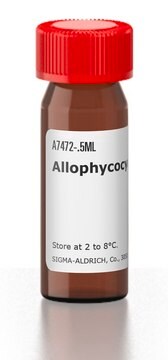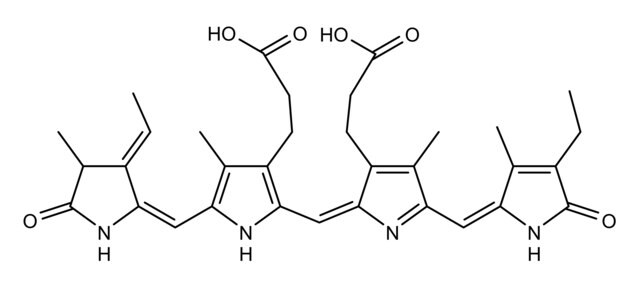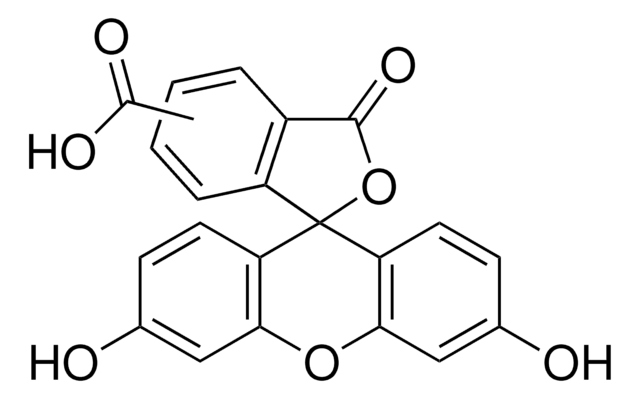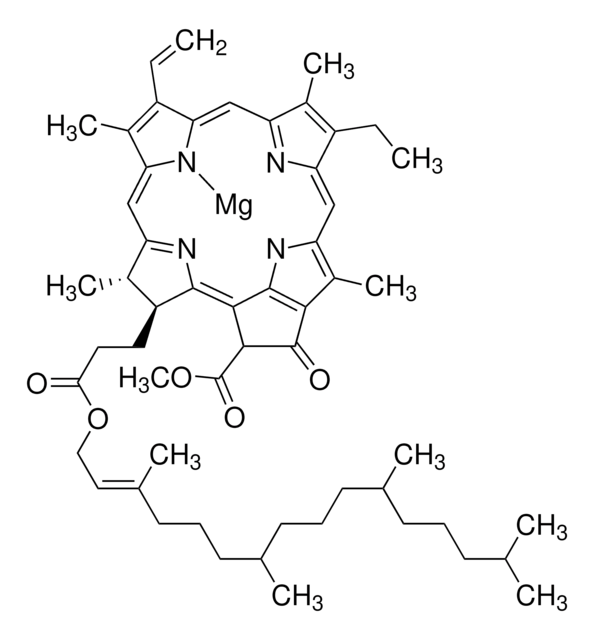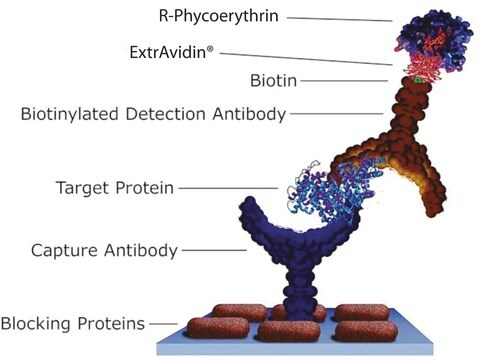추천 제품
제품 라인
BioReagent
농도
≥10.0 mg/mL (UV)
기술
electrophoresis: suitable
형광
λex 542 nm; λem 575 nm in 0.1 M phosphate pH 7.2
적합성
passes test for gel electrophoresis
저장 온도
2-8°C
일반 설명
R-Phycoerythrin or R-PE is a fluorescent probe belonging to the group of phycobiliproteins obtained from macroalgae. R-Phycoerythrin (R-PE) is a protein acting as a photosynthetic accessory pigment in red algae (Rhodophyta). It is an oligomeric protein of 240 kDa, with 6 α (about 20 kDa), 6 β (about 20 kDa), and 1 γ (about 30 kDa) subunits. Phycobiliproteins are water-soluble light-harvesting proteins with a high fluorescent property.
애플리케이션
R-Phycoerythrin (R-PE) is useful in the laboratory as a fluorescence-based indicator for the presence of cyanobacteria and a variety of immunofluorescence applications. R-PE is a useful fluoroprobe in various electrophoretic procedures. R-Phycoerythrin (R-PE) proteins detect mercury ions in soil and groundwater samples. Phycoerythrin has been widely used in food, cosmetics, immunodiagnostics, and analytical reagents.
분석 메모
The product is suspended in 150 mM sodium phosphate, 60% ammonium sulfate, 1 mM EDTA, 1 mM sodium azide, pH 7.0 and must be dialyzed against conjugation buffer or PBS before conjugation.A566/A280 >4.6, A620/A566 <0.03, A566/A498 <1.5
Storage Class Code
12 - Non Combustible Liquids
WGK
WGK 1
Flash Point (°F)
Not applicable
Flash Point (°C)
Not applicable
개인 보호 장비
Eyeshields, Gloves
이미 열람한 고객
Xuefei Sun et al.
Journal of chromatography. A, 1216(1), 159-164 (2008-12-17)
Electric field gradient focusing (EFGF) is a technique used to simultaneously separate and concentrate biomacromolecules, such as proteins, based on the opposing forces of an electric field gradient and a hydrodynamic flow. Recently, we reported EFGF devices fabricated completely from
Joerg Martini et al.
Lab on a chip, 12(23), 5057-5062 (2012-10-10)
We describe an optical detection technique that delivers high signal-to-noise discrimination to enable a multi-parameter flow cytometer that combines high performance, robustness, compactness and low cost. The enabling technique is termed "spatially modulated detection" and generates a time-dependent signal as
Kun Tang et al.
Biochimica et biophysica acta, 1817(7), 1030-1036 (2012-04-03)
Phycobilisomes, the light-harvesting antennas in cyanobacteria and red algae, consist of an allophycocyanin core that is attached to the membrane via a core-membrane linker, and rods comprised of phycocyanin and often also phycoerythrin or phycoerythrocyanin. Phycobiliproteins show excellent energy transfer
Radek Sachl et al.
Biophysical journal, 101(11), L60-L62 (2012-01-21)
Even though superresolution microscopy indicates that size of plasma membrane rafts is <20 nm, those structures have never been observed. Förster resonance energy transfer (FRET) is therefore still the most powerful optical method for characterization of such domains. In this letter
David Rizzo et al.
Cytometry. Part B, Clinical cytometry, 84(2), 125-132 (2012-12-12)
Flow cytometry is the reference technique for assessing ZAP70 expression, a marker of poor prognosis in CLL. One of the most common methods is to assess ZAP70 levels in CLL cells by calculating the ratio between ZAP70 mean fluorescence intensities
자사의 과학자팀은 생명 과학, 재료 과학, 화학 합성, 크로마토그래피, 분석 및 기타 많은 영역을 포함한 모든 과학 분야에 경험이 있습니다..
고객지원팀으로 연락바랍니다.
